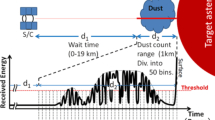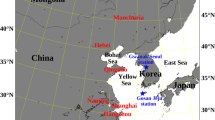Abstract
The concentration distribution of combustible dust determines thermal intensity distribution during an explosion. Current measurements for dust concentration have their particular limitations. Targeting this, we proposed an “ultrasonic-electric” hybrid detection system and a fusion model. We deployed 12 of the ultrasonic-electric hybrid systems in orthogonal arrays to comprehensively observe the clouds. First, the ultrasonic-electric hybrid detection systems obtained concentration data in real time, and those data were calculated by fusion model. Then, the clouds and their concentrations changing with time were depicted. We analyzed those trends and found certain patterns in them. Our approach can provide a fast, accurate way to detect concentrations of dynamic and complex dust. Finally, the corresponding relationship between the dust concentration distribution and its explosive heat intensity distribution is obtained. The results show that the thermal distribution of combustible dust at a concentration of 20-120 g/m3 is proportional to the concentration. This is important for preventing dust explosions and reducing the thermal intensity of explosions.














Similar content being viewed by others
References
Joe S (2011) CNN: 3 Killed in Kansas Grain Elevator Explosion. St. Joseph NewsPress. Publishing HighBeamWeb. https://www.highbeam.com/doc/1P2-29989189.html. Retrieved 21 July 2017
Li G, Yang HX, Yuan CM, Eckhoff RK (2016) A catastrophic aluminium-alloy dust explosion in China. J Loss Prevent Proc 39:121–130
Sanchirico R, Sarli VD, Russo P, Benedetto AD (2015) Effect of the nozzle type on the integrity of dust particles in standard explosion tests. Powder Technol 279:203–208
Eckhoff RK (2006) Differences and similarities of gas and dust explosions: a critical evaluation of the European ‘ATEX’ directives in relation to dusts. J Loss Prevent Proc 19(6):553–560
Liebman I, Conti RS, Cashdollar KL (1977) Dust cloud concentration probe. Rev Sci Instrum 48(10):1314–1316
Cashdollar KL, Liebman I, Conti RS (1981) Three bureau of mines optical dust probes. NASA STI/Recon Technical Report N: 82
Cashdollar KL (1996) Coal dust explosibility. J Loss Prevent Proc 9(1):65–76
Hauert F, Vogl A, Radandt S (1996) Dust cloud characterization and its influence on the pressure-time-history in silos. Process Saf Prog 15:1–8
Wu W, Liu L, Zhang Q (2017) A new 20l experimental vessel for dust explosion and measurement of local concentration. J Loss Prevent Proc 49:299–309
Sewell CJT (1910) The extinction of sound in a viscous atmosphere by small obstacles of cylindrical and spherical form. Philos T R Soc A 210(566):239–270
Epstein PS, Carhart RR (1953) The absorption of sound in suspensions and emulsions 1: water fog in air. J Acoust Soc Am 25(3):553–565
Krause D, Birle S, Hussein MA, Becker T (2011) Bioprocess monitoring and control via adaptive sensor calibration. Eng Life Sci 11(4):402–416
Rodriguez-Molares A, Howard C, Zander A (2014) Determination of biomass concentration by measurement of ultrasonic attenuation. Appl Acoust 81(3):26–30
Zhan XB, Jiang SL, Yang YL, Liang J, Shi TL, Li XW (2015) Inline measurement of particle concentrations in multicomponent suspensions using ultrasonic sensor and least squares support vector machines. Sensors 15(9):24109–24142
Geier D, Heermann K, Hussein M, Becker T (2014) Effects of yeast and maltose concentration on ultrasonic velocity and attenuation coefficient and its application for process monitoring. Eng Life Sci 14(4):433–441
Gu J, Su M, Cai X (2018) In-line measurement of pulverized coal concentration and size in pneumatic pipelines using dual-frequency ultrasound. Appl Acoust 138:163–170
Tian C (2013) Particle concentration characterization in gas-solid two-phase flow by ultrasonic methods. J Eng Thermophys-Rus 34(8):1487–1490
Puers R (1993) Capacitive sensors: when and how to use them. Sensor Actuat A-Phys 37–38(93):93–105
Abouelwafa MSA, Kendall EJM (1980) The use of capacitance sensors for phase percentage determination in multiphase pipelines. IEEE T Instrum Meas 29(1):24–27
Xie CG, Plaskowski A, Beck MSP (1989) 8-electrode capacitance system for two-component flow identification. part 1: Tomographic flow imaging. IEE Proceedings A 136(4):173–183
Dyakowski T, Edwards RB, Xie CG, Williams RA (1997) Application of capacitance tomography to gas-solid flows. Chem Eng Sci 52(13):2099–2110
Xie CG, Plaskowski A, Beck MS (2006) 8-electrode capacitance system for two-component flow identification. II Flow regime identification 136(4):184–190
Wu YD, Shen HL, Zhao XH, Li F (2002) Simulation and computation of effective dielectric constants of diphase composite in two dimensions. Journal of Harbin University of Science Technology 7(6):24–25
Lu G, Zou L, Peng LH, Yao DY, Zhang BF (2003) Two-phase flow concentration measurement method based on principal component analysis. Journal of China Institute of Metrology 14(1):15–18
Shafquet A, Ismail I, Jaafar A (2014) Modeling and simulation of multi-plane Electrical Capacitance Tomography sensor for flow imaging by using Finite Element Analysis. I.C.I.A.S. https://doi.org/10.1109/ICIAS.2014.6869489
Bidabadi M, Yosefi SH, Poorfar AK, Hajilou M, Zadsirjan S (2014) Modelling Combustion of Magnesium Dust Cloud in Heterogeneous Media. Combustion Explosion and Shock Waves 50(6):658–663
Bidabadi M, Hajilou M, Poorfar AK, Yosefi SH, Zadsirjan S (2014) Modeling flame propagation of micron-sized iron dust particles in media with spatially discrete sources. Fire Saf J 69:111–116
Allegra JR, Hawley SA (1972) Attenuation of sound in suspensions and emulsions: Theory and experiments. J Acoust Soc Am 51(5):1545–1546
Basdevant N, Haduong T, Daniel B (2004) Dielectric constant of a highly polarizable atomic fluid: the clausius–mossotti versus the onsager relation. Mol Phys 102(8):783–788
Mahan GD (1980) Octupole modifications of the Clausius-Mossotti relation. Solid State Commun 33(7):797–800
Guo MR, Lou WZ, Jin X, Dai XM (2016) Experimental research on dynamic concentration distribution of FAE solid fuel. Acta Armamentarii 37(2):226–231
Acknowledgments
The research is supported by the State Key Laboratory of Mechatronics Engineering and Control and sponsored by National Project (20160229150) the Open Research of Beijing Information Science and Technology University (KF20191123205).
Author information
Authors and Affiliations
Contributions
W.L. and H.W conceived the problem and designed the solution; Y.Z. and M.G. designed the experiments; Y.Z. performed the experiments; S.F. analyzed the data; Y.Z. wrote the paper.
Corresponding author
Additional information
Publisher’s note
Springer Nature remains neutral with regard to jurisdictional claims in published maps and institutional affiliations.
Rights and permissions
About this article
Cite this article
Zhang, Y., Lou, W., Wang, H. et al. Experimental research on dynamic concentration distribution for combustible dust based on ultrasonic-electric hybrid detection. Heat Mass Transfer 56, 1673–1684 (2020). https://doi.org/10.1007/s00231-019-02807-7
Received:
Accepted:
Published:
Issue Date:
DOI: https://doi.org/10.1007/s00231-019-02807-7




